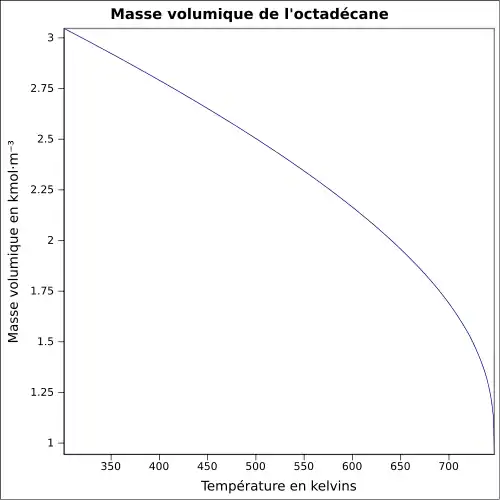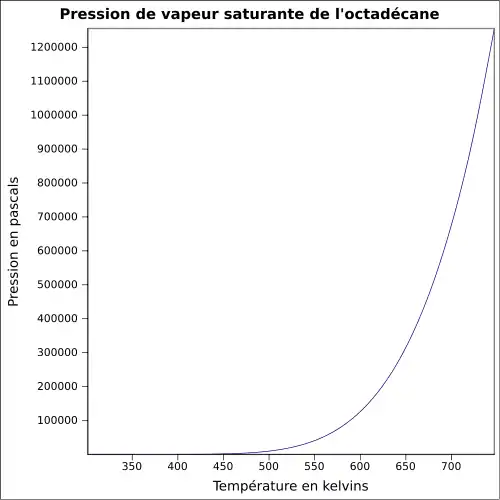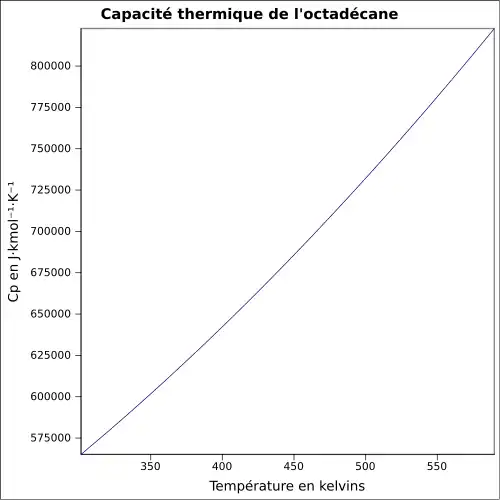Octadécane
L'octadécane ou n-octadécane est l'alcane linéaire de formule brute C18H38. C'est aussi le nom générique des isomères de formule C18H38.
| Octadécane | ||
| Représentations 3D de l'octadécane | ||
| Identification | ||
|---|---|---|
| Nom UICPA | Octadécane | |
| Synonymes |
n-octadécane |
|
| No CAS | ||
| No ECHA | 100.008.902 | |
| No CE | 209-790-3 | |
| SMILES | ||
| InChI | ||
| Propriétés chimiques | ||
| Formule | C18H38 [Isomères] |
|
| Masse molaire[1] | 254,494 3 ± 0,017 1 g/mol C 84,95 %, H 15,05 %, |
|
| Propriétés physiques | ||
| T° fusion | 301.0 ± 0.7 K (27,8 ± 0,7 °C)[2] | |
| T° ébullition | 589.3 K (316,15 °C)[3] | |
| Masse volumique | ||
| Pression de vapeur saturante | ||
| Point critique | 1 290 kPa[5], 472,65 °C[6] | |
| Thermochimie | ||
| ΔfusH° | 205,1 kJ/kg[7] | |
| Cp | ||
| Précautions | ||
| SGH[9] | ||
 |
||
| Unités du SI et CNTP, sauf indication contraire. | ||
Synthèse
L'octadécane peut être obtenu par désoxygénation de l'octadécanol avec le N-Hydroxysuccinimide[10].
Utilisation
Grâce à son importante enthalpie de fusion, l'octadécane est utilisé comme matériau à changement de phase, avec des applications notamment dans l'isolation thermique des bâtiments[11]. Pour cela, de nombreuses études cherchent à l'encapsuler[12]via différentes méthodes[13],[14].
Notes et références
- Masse molaire calculée d’après « Atomic weights of the elements 2007 », sur www.chem.qmul.ac.uk.
- NIST
- CRC Handbook of Data on Organic Compounds, 2nd Edition, Weast,R.C and Grasselli, J.G., ed(s)., CRC Press, Inc., Boca Raton, FL, 1989, 1.
- (en) Robert H. Perry et Donald W. Green, Perry's Chemical Engineers' Handbook, USA, McGraw-Hill, , 7e éd., 2400 p. (ISBN 0-07-049841-5), p. 2-50
- (en) Iwona Owczarek et Krystyna Blazej, « Recommended Critical Pressures. Part I. Aliphatic Hydrocarbons », J. Phys. Chem. Ref. Data, vol. 35, no 4, , p. 1461 (DOI 10.1063/1.2201061)
- (en) Iwona Owczarek et Krystyna Blazej, « Recommended Critical Temperatures. Part I. Aliphatic Hydrocarbons », J. Phys. Chem. Ref. Data, vol. 32, no 4, , p. 1411 (DOI 10.1063/1.1556431)
- Amar M. Khudhair, Mohammed M. Farid, A review on energy conservation in building applications with thermal storage by latent heat using phase change materials, Energy Conversion and Management 45 (2004) 263–275.
- (en) Carl L. Yaws, Handbook of Thermodynamic Diagrams : Organic Compounds C8 to C28, vol. 3, Huston, Texas, Gulf Pub. Co., , 396 p. (ISBN 0-88415-859-4)
- https://pubchem.ncbi.nlm.nih.gov/compound/octadecane#datasheet=LCSS§ion=GHS-Classification
- Mark S. Baird, Armin de Meijere, Nicola Chessum, Sylvain Couty, Adam Dzielendziak, Science of Synthesis: Houben-Weyl Methods of Molecular Transformations Vol. 48: Alkanes, Georg Thieme Verlag, 2014, pages 212-213.
- L.F. Cabeza, A. Castell, C. Barreneche, A. de Gracia, A.I. Fernández, Materials used as PCM in thermal energy storage in buildings: A review, Renewable and Sustainable Energy Reviews 15 (2011) 1675–1695
- Hassan, Ahmed & Laghari, Mohammad & Rashid, Yasir. (2016). Micro-Encapsulated Phase Change Materials: A Review of Encapsulation, Safety and Thermal Characteristics. Sustainability. 8. 1046. 10.3390/su8101046.
- A. Jamekhorshid, S.M. Sadrameli, M. Farid, A review of microencapsulation methods of phase change materials (PCMs) as a thermal energy storage (TES) medium, Renewable and Sustainable Energy Reviews 31 (2014) 531–542.
- Su, W., Darkwa, J. & Kokogiannakis, G. (2015). Review of solid-liquid phase change materials and their encapsulation technologies. Renewable and Sustainable Energy Reviews, 48 373-391.
- Portail de la chimie
Cet article est issu de Wikipedia. Le texte est sous licence Creative Commons - Attribution - Partage dans les Mêmes. Des conditions supplémentaires peuvent s'appliquer aux fichiers multimédias.


